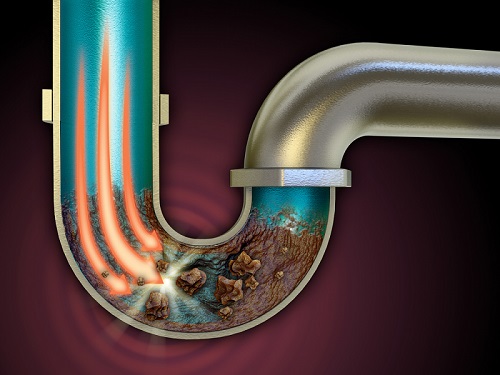Coming to terms with a clogged septic tank pipe can be annoying. The tank’s blockage may cause sewage backlog, smells, and delayed drainage. Preventing additional harm and health risks requires immediate action.
To unclog a pipe that goes to your septic tank, you can attempt several ways, such as using a plunger, drain snake, or hydro jetting. If the clog’s origin is a root intrusion or a broken pipe, call a plumber to identify and fix it.
Read this article to learn how to unclog a septic pipe and restore plumbing in detail.
How to Unclog Pipe to Septic Tank: An Overview
Let us get a brief idea of how to unclog a pipe that is directed to the septic tank by going through this table.
| Method |
Description |
|
Identify the clogged drain |
Locate the cause of any drainage issues, such as sluggishness or a bad smell. |
|
Clear any obstructions |
Clean the drain or pipe of any obvious clogs, such as hair or grease. |
|
Use a plunger |
To remove a clog, cover the drain completely, and thrust the water in with great force. |
|
Try a drain snake or hydro jetting |
Hydro jetting uses a high-pressure spray of water to blast away the obstacle, while a drain snake may be used to destroy and remove obstructions. |
| Call a professional |
If the clog continues or you suspect a broken pipe, contact a professional plumber or septic tank expert for help. |
Signs of a Clogged Pipeline
Some of the symptoms of a blocked pipeline include as follows.
Slow Draining Fixtures
When water takes longer than normal to drain from sinks, showers, or toilets, it may be an indication of a clog in the pipeline. There are several potential causes for sluggish drainage, including trash buildup, grease deposition, and foreign objects in the pipe.
Gurgling Sounds
A gurgling sound in the washbasin or toilet indicates that air is stuck in the plumbing system. This occurs when a blockage in the pipeline prevents air from passing through. Another possible sign of a full septic tank is gurgling noises.
Bad Smells
If you notice a foul stench emanating from your toilets, sinks, or drains, this might be a symptom of clogging. When sewage backs up because of a blocked pipe, the resulting smell may be overpowering.
Sewage Backups
Clogs in sewage lines may lead to backups, which can contaminate your house or yard if they are severe enough. This is unmistakable evidence of a serious bottleneck that requires quick attention.
The key to avoiding more serious problems is finding a blocked pipeline as soon as possible. Take urgent action if you observe any of these symptoms to prevent additional harm to your septic system.
Steps to Unclog a Pipe to Septic Tank
Here’s a full description of the ways to unclog a pipeline to a septic tank:
Step 1: Gather Required Tool
Before commencing the process of unclogging a pipeline, it is crucial to gather the appropriate tools and safety equipment. These may contain gloves, goggles, a plumbing snake or hydro jet, a bucket, and a flashlight.
Step 2: Find the Blocked Pipe
The next one is finding the blocked pipe. After you have acquired the essential tools and equipment, the following step is to locate the clogged pipeline. This may be done by identifying the plumbing fixtures that are suffering the most serious concerns, such as sluggish draining or backups.
Step 3: Use a Plunger
Then try using a plunger. If the blockage is very slight, you may try to dislodge it with a plunger. Put the plunger over the problem drain and pump it up and down numerous times. This generates suction, which may assist in removing the blockage and letting water flow freely.
Step 4: Use a Plumbing Snake or Hydro Jet
If the plunger is ineffective, the next step is to use a plumbing snake or hydro jetting to clear the clog. A plumbing snake is a long, flexible instrument that may be placed into the pipeline to break apart and remove the blockage.
Hydro jetting employs high-pressure water to clean up the pipeline. It is crucial to follow the manufacturer’s instructions and take proper safety precautions while using these instruments.
Step 5: Remove the Rubbish
Remove the rubbish. If the blockage is due to obvious obstructions, such as hair or debris, use gloves or tongs to remove them. Pouring hot water down the pipes might assist in dislodging any residual clogs.
Step 6: Take Preventive Measures
Preventative steps to avoid clogs in the future should be taken. After the pipeline is unclogged, take preventive measures to avoid obstructions in the future.
Some of these measures include keeping grease and oil out of the drain, installing drain covers to collect hair and debris, and scheduling routine septic tank pumping.
Unclogging a pipe leading to a septic tank may seem like an easy chore, but it’s crucial to do it safely so that no more harm or injury is done.
Maintenance of the Septic System
Particularly in rural locations, septic systems are not linked to a municipal sewage system. It is an integral feature of many residences. Its purpose is to dispose of domestic wastewater in a sanitary and effective way.
So, your septic system has to be regularly maintained to ensure its continued efficiency.
- Pump the system with regular intervals: Pump your septic tank every 3-5 years, depending on size and use. Pumping prevents sediments from clogging the system and causing backups.
- Use water efficiently: Excessive water consumption might overwhelm your septic system and impede efficiency. Installing low-flow toilets, replacing leaking taps, and spreading laundry loads reduce water use.
- Avoid flushing non-biodegradables: Feminine hygiene items, wipes, diapers, and cooking oil that don’t break down rapidly might clog your system.
- Avoid pouring chemicals: Chemicals may destroy septic tank microorganisms, so avoid pouring them down the drain.
- Maintain drain fields: Septic systems process and dispose of liquid waste in drain fields. Driving or parking on the drain field and planting trees or other deep-rooted plants nearby might harm the system.
- Ensure regular checking: Frequent system checks may catch issues before they become major. Check for backups; sluggish drainage smells, and more. Professionals may examine your system every few years.
Safety Precautions When Working with a Septic System
Unclogging pipe to a septic tank includes hazardous chemicals and restricted places. Here are septic system safety tips when you want to work with it.
Wear appropriate protective equipment
Use gloves, goggles, and a respirator or face mask while dealing with septic systems. This prevents germs and gas exposure.
Ventilate the area
Septic tanks and other components may release methane and hydrogen sulfide. Avoid cramped places and ventilate before operating.
Use proper tools and equipment
Employ septic system-specific tools. Pumps, hoses, and other specialized equipment are examples. Misusing tools may cause accidents and injuries.
Avoid smoking and open flames
Smoking and open fires may ignite septic system gases like methane. Avoid smoking and keep ignition sources away from work.
Don’t work alone
Septic systems are risky, so have someone nearby in case of an emergency. Work with someone who can help if feasible.
Follow proper disposal procedures
Dispose of septic system waste properly. Waste may be disposed of in authorized places or at a specialized facility.
Seek professional help
Get expert aid if you’re unclear on how to properly operate your septic system or run into a situation you can’t manage. A licensed septic system specialist can safely and efficiently maintain your system.
Frequently Asked Questions
Let us know some commonly asked questions on how to unclog the pipe to the septic tank.
How can I unclog a sewer line the easiest way?
To do this, mix two parts vinegar to one part baking soda with 60 gallons of water. As you pour the water down the drain, use a drain snake or plunger to move any debris that is blocking the water flow.
What should I do if sewage backs up into my home?
If you have a sewage backup, you should act quickly to avoid health risks and property damage. Cut off the water supply to your property and avoid using any drains or flushing toilets.
Immediately arrange for a qualified plumber or septic system expert to examine the problem and make any required repairs.
What kills the roots in septic lines?
In a septic tank system, there are chemicals made to kill tree roots so they don’t grow back. Most people use copper sulfate to treat their septic tanks. This technique is particularly effective because it makes a poisonous barrier in the root system that kills the tree branches before they can expand into the pipe.
Conclusion
In conclusion, a clogged pipe related to your septic tank can be a dangerous problem. You may attempt other techniques to clear the pipe, but septic systems are unsafe. Call a plumber or septic system specialist if you’re unsure if the obstruction is serious.
Avoid flushing non-degradable materials, use drain strainers, and get your septic system cleaned and pumped periodically to prevent obstructions. If you have a blocked pipe, act quickly and get expert aid to safeguard your septic system and health.

